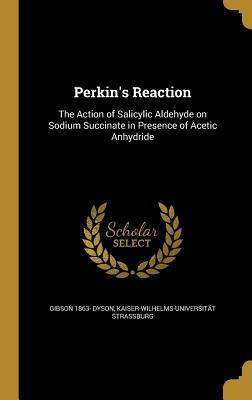Read Online Perkin's Reaction: The Action of Salicylic Aldehyde on Sodium Succinate in Presence of Acetic Anhydride - Gibson Dyson | ePub
Related searches:
This finding showed that the synthesized compound had antioxidant activity. Cinnamic acid; perkin reaction; photoprotective; sonochemistry; structure.
We have known about the origins of our disaster for longer than we like to imagine. More than 150 years ago, george perkins marsh (1801–1882) published man and nature; or, physical geography as modified by human action — a study of how human action modifies the physical world, from the crust of the earth to the atmosphere.
A new experimental technique, greatly increasing the yield of the perkin-reaction on benzaldehyde and succinic acid is described.
Cinnamic acid) from an aromatic aldehyde, an acid anhydride and a salt of the corresponding acid, is now known as the perkin reaction; he used it, in 1868, to manufacture the first synthetic perfume, coumarin.
12 sep 2020 it gives an α,β-unsaturated aromatic acid by the aldol condensation of an aromatic aldehyde and an acid anhydride, in the presence of an alkali.
1 apr 2014 keywords: cinnamic acid; cis–trans isomerization; perkins reaction.
Perkin reaction is an organic chemical reaction which was discovered by william henry perkin, an english chemist. Perkin reaction mechanism includes the reaction between aromatic aldehydes, the aliphatic acid anhydride, and the alkali salt of the acid to give cinnamic acid derivatives.
30 may 2018 keywords: perkin reaction; condensation reaction; unsaturated carboxylic acid; acidic anhydride; aldehyde; aromatic aldehyde.
The perkin reaction is an organic reaction developed by william henry perkin that is used to make cinnamic acids. It gives an α,β-unsaturated aromatic acid by the aldol condensation of an aromatic aldehyde and an acid anhydride, in the presence of an alkali salt of the acid.
A perkin reaction yields a beta unsaturated aromatic acid ('beta unsaturated' meaning it contains a double bond), containing carboxylic acid group by the aldol condensation of an aromatic aldehyde.
1 may 2002 the action of pyridine as a catalyst in perkin's synthesis of cinnamic acid the perkin reaction and related reactions.
Perkin's reaction� the action of salicylic aldehyde on sodium succinate in presence of acetic anhydride by dyson, gibson, 1863-� kaiser-wilhelms-universität strassburg.
Introduction: • the perkin reaction is an organic reaction used to convert an aromatic aldehyde and an anhydride to an α,β-unsaturated carboxylic acid • it is aldol condensation of an aromatic aldehyde and an acid anhydride (which contain alpha hydrogen), in the presence of an alkali salt of the acid.
The pechmann condensation is a synthesis of coumarins, starting from a phenol and a carboxylic acid or ester containing a β- carbonyl group. The mechanism involves an esterification/transesterification followed by attack of the activated carbonyl ortho to the oxygen to generate the new ring.
Perkin had his own ideas for the synthesis of quinine and pursued them in his lab at his parents' home. During easter break 1856 perkin ran a reaction with aniline (a compound derived from coal tar) and potassium dichromate that produced a black sludge.
14 apr 2017 in this reaction i explained one the important organic name reaction.
In the presence of an acetic anhydride-sodium acetate mixture, under the operating conditions of the perkin reaction.
The broad spectrum of biological activities has made them privileged structures in combinatorial drug discovery.
Perkin's reaction� the action of salicylic aldehyde on sodium succinate in presence of acetic anhydride. Thanks for sharing! you submitted the following rating and review.
Perkin reaction mechanism includes the reaction between aromatic aldehydes, the aliphatic acid anhydride, and the alkali salt of the acid to give cinnamic.
The known action of alkali on 3,6-dibenzyl-1,4-dihydro- s -tetrazines to form 1,3,4-oxadiazoles has been shown to require the presence of an oxidising agent and tetrazine can play this role.
4 jan 2014 cinnamic acid synthesis from aryl aldehyde and acetic anhydride. Inorganic chemistry organic chemistry acid synthesis detailed.
The perkin reaction is an organic reaction developed by english chemist william henry perkin that is used to make cinnamic acids. It gives an α,β-unsaturated aromatic acid by the aldol condensation of an aromatic aldehyde and an acid anhydride, in the presence of an alkali salt of the acid.
In this work, coumarin was synthesized by perkin reaction using salicylaldehyde, acetic acid and sodium acetate.
The effects of β-alkoxy substituents on radical reactions: halogen-atom abstraction from alkyl chlorides.
Pechmann, claisen, reformatsky, and knoevenagel pathways (17).
The perkin reaction is a condensation reaction of organic chemistry. It involves the formation of α, β unsaturated carboxylic acid from aromatic aldehydes and anhydride in presence of a base catalyst which is alkali salt of the acid. The reaction was first discovered by william henry perkin in the 19 th century, who was an english chemist.
The perkin reaction involves the condensation of a carboxylic acid anhydride and an aldehyde in the presence of a weak base, often the sodium or potassium.
The influence of groups on the yiedls obtained during perkin's reaction under standardised conditions. A comparison can thus be made of the influence of groups in perkin's reaction with the influence in the pyridine-trace condensation. Under the conditions chosen, these workers obtain a yield of 49% of cinnamic acid from benzaldehyde.

Post Your Comments: